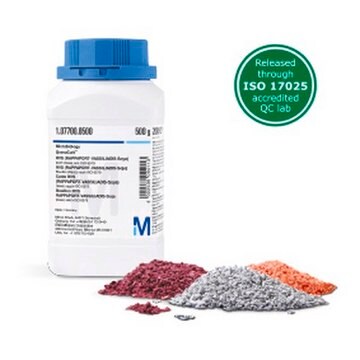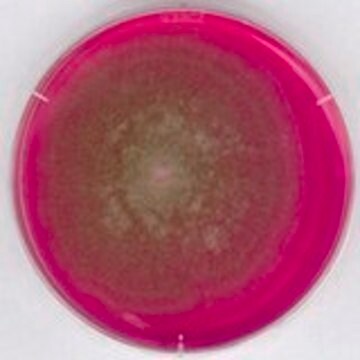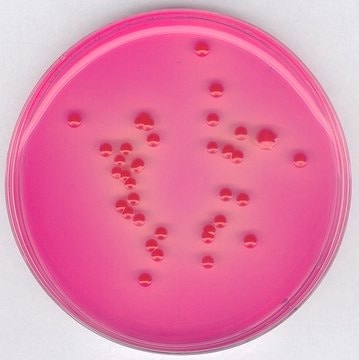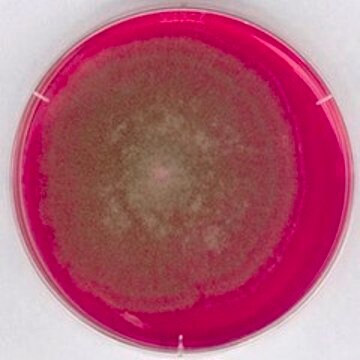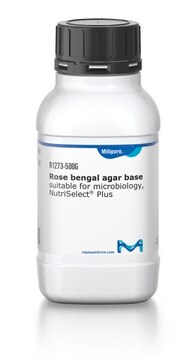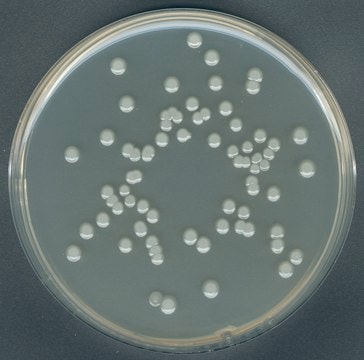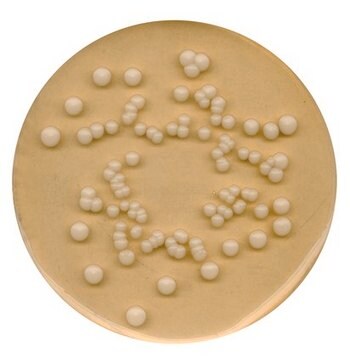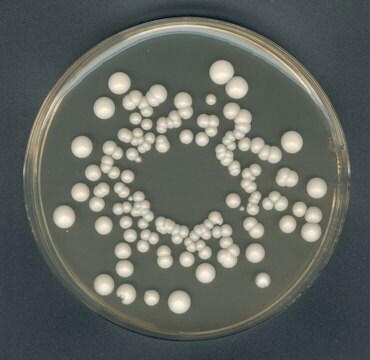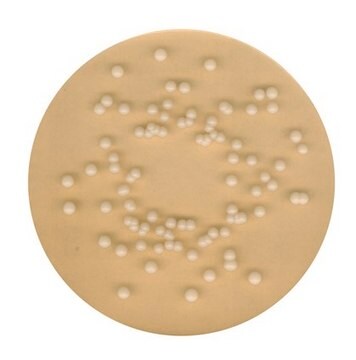1.00467
GranuCult® plus Rose-Bengal Chloramphenicol Agar (RBC)
for yeasts, for molds, suitable for microbiology
Synonym(s):
RBC Agar, Yeast and mold medium
Sign Into View Organizational & Contract Pricing
All Photos(1)
About This Item
UNSPSC Code:
41106213
NACRES:
NA.74
Recommended Products
sterility
non-sterile
Quality Level
form
granular
manufacturer/tradename
GranuCult® plus
packaging
pkg of -500 g
storage condition
dry media (Tightly closed)
technique(s)
microbiological culture: suitable
color
pink
pH
7.0-7.4 (25 °C, 33.2 g/L in H2O)
solubility
33.2 g/L
application(s)
food and beverages
microbiology
storage temp.
15-25°C
suitability
molds
yeasts
General description
GranuCult® plus Rose-Bengal Chloramphenicol Agar is a selective agar for the enumeration of yeasts and molds in foodstuffs. The neutral pH in combination with chloramphenicol suppresses the growth of most bacteria. Rose-Bengal, taken up intracellular by fungi, restricts the size and the spreading of molds, preventing the overgrowth of slow-growing species by luxuriant species.
Application
GranuCult® plus Rose-Bengal Chloramphenicol Agar is suitable for the enumeration of yeasts and molds in foodstuffs, particularly proteinaceous food.
Features and Benefits
- GranuCult® offers superior granulated culture media.
- Safe and sustainable due to reduced risks associated with fine dust and toxic substance inhalation, resulting in a safer work environment.
- Excellent wettability, solubility, and free-flowing properties
- Convenient, with minimal component separation and clumping, even under warm or humid conditions.
- High batch-to-batch reproducibility
- Prolonged shelf life of up to five years
- High number of test strains exceeding all regulatory demands
- Granulation technology allows many supplements to be included, with no need to add these separately
Analysis Note
Appearance (clearness): turbid
Appearance (colour): pink to red
pH-value (25 °C): 7.0 - 7.4
Inoculum on reference medium (Saccharomyces cerevisiae ATCC 9763 (WDCM 00058)): 10 - 100
Inoculum on reference medium (Rhodotorula mucilaginosa DSM 70403): 10 - 100
Colony count (Saccharomyces cerevisiae ATCC 9763 (WDCM 00058)):
Colony count (Rhodotorula mucilaginosa DSM 70403):
Recovery on test medium (Saccharomyces cerevisiae ATCC 9763 (WDCM 00058)): ≥ 50 %
Recovery on test medium (Rhodotorula mucilaginosa DSM 70403): ≥ 50 %
Growth (Mucor racemosus ATCC 42647): fair to good
Growth (Escherichia coli ATCC 25922 (WDCM 00013)): none
Growth (Enterococcus faecalis ATCC 29212 (WDCM 00087)): none
Incubation: 5 days; 22 °C; aerobic.
Appearance (colour): pink to red
pH-value (25 °C): 7.0 - 7.4
Inoculum on reference medium (Saccharomyces cerevisiae ATCC 9763 (WDCM 00058)): 10 - 100
Inoculum on reference medium (Rhodotorula mucilaginosa DSM 70403): 10 - 100
Colony count (Saccharomyces cerevisiae ATCC 9763 (WDCM 00058)):
Colony count (Rhodotorula mucilaginosa DSM 70403):
Recovery on test medium (Saccharomyces cerevisiae ATCC 9763 (WDCM 00058)): ≥ 50 %
Recovery on test medium (Rhodotorula mucilaginosa DSM 70403): ≥ 50 %
Growth (Mucor racemosus ATCC 42647): fair to good
Growth (Escherichia coli ATCC 25922 (WDCM 00013)): none
Growth (Enterococcus faecalis ATCC 29212 (WDCM 00087)): none
Incubation: 5 days; 22 °C; aerobic.
Footnote
We offer two media types: the superior granulated GranuCult® and the cost-efficient powdered NutriSelect® culture media, depending on your needs.
The designations basic, plus, or prime are added to indicate the quality control level, from basic quality control to standard QC plus to prime for full regulatory compliance.
The designations basic, plus, or prime are added to indicate the quality control level, from basic quality control to standard QC plus to prime for full regulatory compliance.
Legal Information
GRANUCULT is a registered trademark of Merck KGaA, Darmstadt, Germany
NutriSelect is a registered trademark of Merck KGaA, Darmstadt, Germany
related product
Product No.
Description
Pricing
Storage Class Code
11 - Combustible Solids
WGK
WGK 3
Certificates of Analysis (COA)
Search for Certificates of Analysis (COA) by entering the products Lot/Batch Number. Lot and Batch Numbers can be found on a product’s label following the words ‘Lot’ or ‘Batch’.
Already Own This Product?
Find documentation for the products that you have recently purchased in the Document Library.
Our team of scientists has experience in all areas of research including Life Science, Material Science, Chemical Synthesis, Chromatography, Analytical and many others.
Contact Technical Service